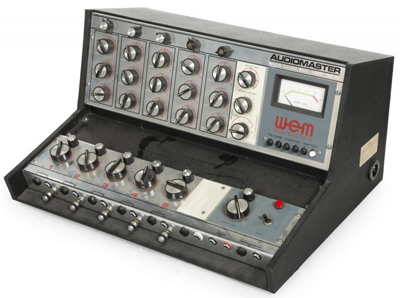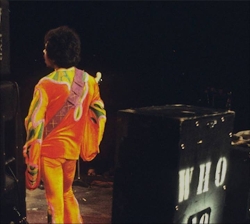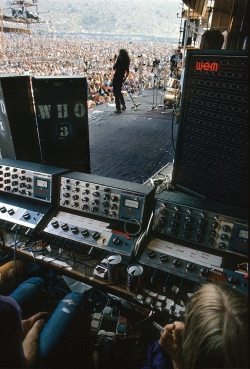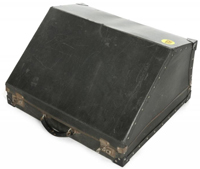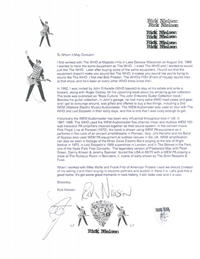The Who’s PA: 1969–1970
1969
As the Who began to play larger venues and saw success with Tommy, PA also progressed, growing larger, reportedly using 12 to 16 WEM columns per stage-side by 1969. Also in 1969, WEM had pioneered the festival sound system. Likely around this time, bands began miking up the drums and instrument amplifiers, bringing a more balanced mix to the overall sound, projecting both vocals and instruments. The Who had long established themselves as the loudest act, but were known for high-quality PA, not just brute volume.
Selected quotes
All quotes and references are copyright their original owners and are included for reference only.
The Who Concert File:
The introduction of Tommy into the live act coincided with a period when The Who had established a formidable system of amplification and on-stage sound. They could now vary their PA system to cover outdoor festivals and small college ballrooms and always deliver a trademark ear-splitting level of volume. But unlike a whole legion of heavy metal bands who took their cue from their pioneering “bigger-louder-wall-of-Marshalls” approach, The Who’s sound always had depth, clarity and musical muscle within the decibel output. The skills of sound-engineer Bob Pridden, and a commitment to developing and investing in new technology, mean The Who always sounded better than all other groups.
Richard Barnes:
Pete talked about “trying to sophisticate our sound a little, make it a little less ear-rending … We haven’t got any louder but our PA has got bigger. It’s now 1500 watts and it just chucks it all out. That is what’s deafening people. One our troubles is Moon — he’s so deafening. If we do a two and a half-hour show he just starts playing like a machine. I’m sure he puts out more watts than the rest of us put together.”
From 2015 Sound on Sound interview with Bob Pridden:
In 1969, the Who moved over to WEM [Watkins Electric Music] PA systems, comprising varying numbers of WEM speaker columns and a WEM Audiomaster mixing desk. But, as Bob Pridden explained, with the group gigging at increasingly larger venues, including huge open-air festivals such as the 1969 and 1970 Isle Of Wight events, the WEM system no longer fulfilled the Who’s ambitious sonic requirements.
“The WEM system just outgrew itself,” says Bob. “We ended up with about two or three thousand Watts of WEM stuff which we used at the Isle Of Wight festival, and then we bumped that up with Pink Floyd’s WEM system to make it even bigger but, really, with that stuff, for every 1000 Watts, you only get about a couple of extra dB, so it really didn’t cover big gigs like that. In those days everyone suffered with that problem. The second Isle Of Wight [1970] was just so big and that’s when you needed to get something with horns in it to project the sound. The WEM system was great at smaller venues because it was a big hi-fi system, but when you started playing to crowds of, like, 50,000, 100,000 or whatever, it just didn’t work.”
WEM Copicat
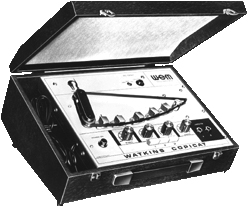
Around 1969, Bobby Pridden began using the WEM Copicat tape-echo unit to add sound coloration to the instrument amplification.
The Copicat was not necessarily used for vocals, but for the guitar; at times, Pete would even use three Copicats on his guitar.
The WEM Copicat first appeared in 1954 and had been used by bands in the early ’60s as a primitive PA mixer. Early versions of the Copicat were valve-based with a permanent magnet to erase the tape each loop; the Mk IV introduced in the late ’60s used transistors and a proper tape erase head in place of the magnet.
Features: echo volume; sustain/reverberation; echo selectors, volume controls for each input, and a 22½″ (570 mm.) welded tape loop.
From 2015 Sound on Sound interview with Bob Pridden:
When we were in Scandinavia [mid-1968], we found a PA called an Ackuset, which we started using with the Marshall system. The Hollies used to have one too and we thought if they were using it, it must be good, so we got one and that had an echo built in. That’s when all that started, and that echo unit was a great little unit, actually. After that, I started to get into [Watkins and Maestro] Copicats and Echoplexes, and Binsons. There were all kinds of echo units that I used to use on Pete’s guitars and on vocals.”
See Watkins Guitars for more information.
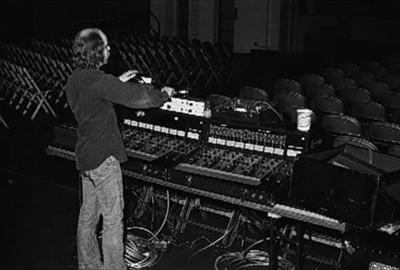
Click to view larger version. Heil front-of-house with two Sunn Coliseum Audio Controller 8-ch. boards. WEM Copicat echo unit for tape echoes visible on top of right-side desk. (Photo: SoundCityChris)
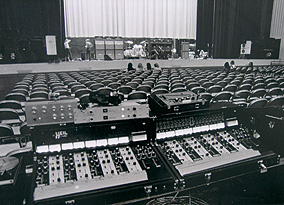
12 April 1972, Kiel Opera House, St. Louis, Missouri, for West, Bruce & Laing, with one WEM Copicat at FOH with two Heil-built FOH Sunn Coliseum boards, JBL 5101 mic preamps and a Sony mixer. Heil Sunn PA being set up on stage.
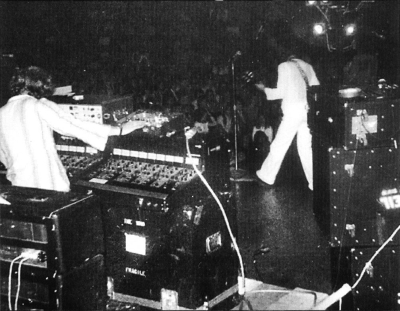
Click to view larger version. 21 Aug. 1972, KB-Hallen, Denmark, WEM Copicat echo unit for tape echoes visible on top of Bob Pridden’s Heil-built Sunn Coliseum Audio Controller 8-ch. boards.
The Who also began using stage monitoring around this time, with stage-side and behind-the-drumkit speaker columns from WEM.
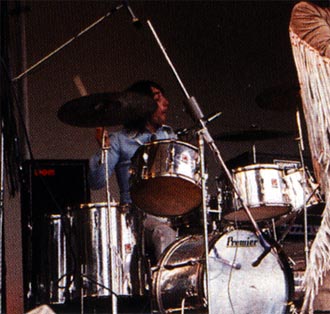
30 Aug., 1969, the 2nd Annual Isle of Wight festival, which featured The Who’s 2,500-watt WEM PA system. WEM speaker column behind Keith’s kit as foldback.
“Also in 1969, the idea of stage monitors was tentatively imported from the United States. Bobby Pridden, The Who’s sound engineer, persuaded Charlie Watkins to modify his Audiomasters, adding an extra output for stage monitors. The signal then passed to a WEM 100-watt amplifier and a speaker cabinet was placed in front of Roger Daltrey so he could hear himself. But monitors cost money and it was so unusual and satisfying to have a good PA sound out front that stage monitors were largely disregarded until the novelty of high-power PA had been surpassed.”
From 2015 Sound on Sound interview with Bob Pridden:
Bob Pridden estimates that it was back in 1969 — around the same time the Who had just started using WEM PA gear — that he and the band first began experimenting with on-stage monitors.
“We just started thinking, ‘How can we hear ourselves?’” says Bob. “And then I got an amp with a volume control and turned two speakers with the full mix inwards across the stage, like two side fills. Then I just took it down a bit so it didn’t feed back, and that really was the beginning of monitors.”
Festivals
The large US festivals, such as Woodstock, had festival-supplied PA. The PA sound at the Woodstock festival was reportedly “faint.” Reportedly 10 McIntosh MC-3500 350-watt tube amps powered the PA.
30 Aug., 1969 – Second Annual Isle of Wight Festival
The festival featured The Who’s 2,500-watt WEM PA system. (The accounts from the era report: “WEM are supplying a 2,000 watts PA system which is claimed to be the biggest ever used anywhere in the world. … A 2,000 watt PA system is also being flown over specially from the States.”)
The Who Concert File:
The PA system was the largest that had ever been assembled at that point and Pete joked that it was built from Meccano. For The Who’s set, signs were erected on the speakers warning people to keep at least 15 feet away.
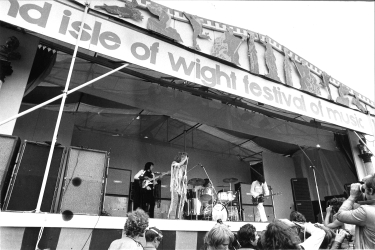
30 Aug., 1969, the 2nd Annual Isle of Wight festival, which featured The Who’s 2,500-watt WEM PA system. Three of The Who’s Marshall 8×10 cabs visible at stage-right, and two stacked WEM cabinets as foldback seen at far right.
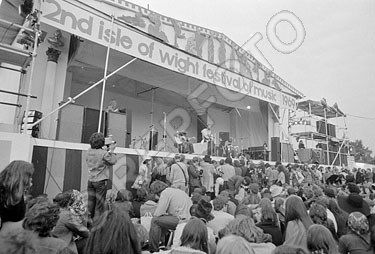
30 Aug., 1969, the 2nd Annual Isle of Wight festival, which featured The Who’s 2,500-watt WEM PA system. A wider shot of the Who’s PA setup at the festival (though with Richie Havens performing). Three of The Who’s Marshall 8×10 cabs are visible at stage-right, and a stack of WEM slaves or PA amps are visible at far left.
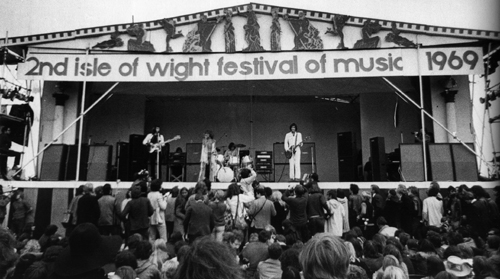
30 Aug., 1969, the 2nd Annual Isle of Wight festival, which featured The Who’s 2,500-watt WEM PA system. Visible are three Marshall 8×10 PA cabinets per stage side, and WEM columns and cabs set up in the backline as foldback.
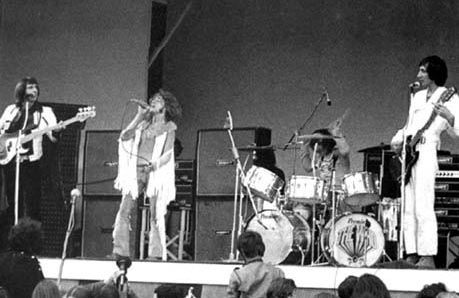
30 Aug., 1969, the 2nd Annual Isle of Wight festival, which featured The Who’s 2,500-watt WEM PA system. WEM speaker columns and cabinets as foldback behind John and Keith.
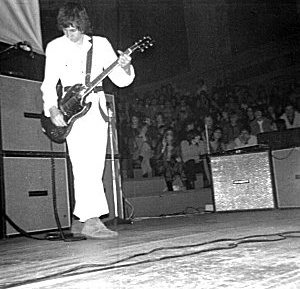
29 Sept., 1969, Amsterdam, Concertgebouw, with Hiwatt SE4122 4×12 cabinets as foldback (and spare guitar stand) at stage left. Courtesy The Who Netherlands Photo Gallery (offline). ©Henk Hulstkamp.
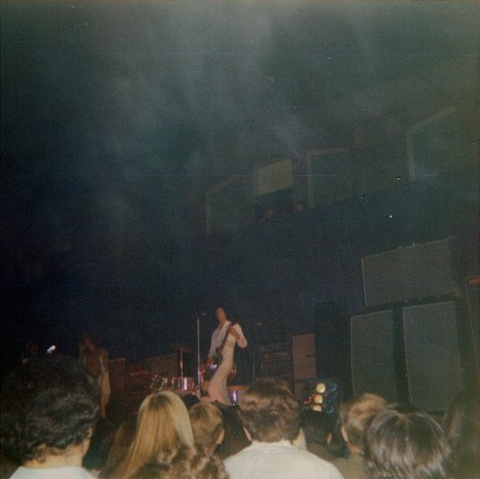
10 Oct., 1969, Commonwealth Armory, Boston, with Marshall 8×10 cabinets and WEM column.
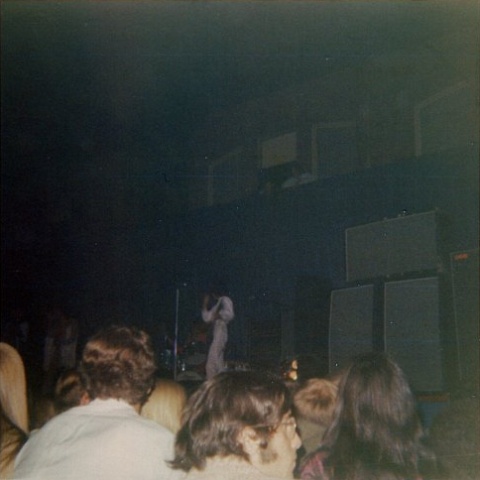
10 Oct., 1969, Commonwealth Armory, Boston, with Marshall 8×10 cabinets and WEM column.
1970
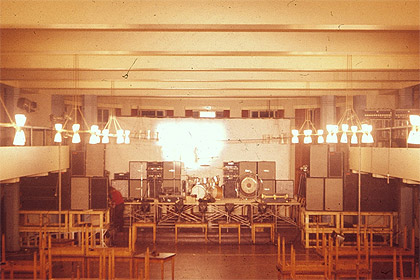
Click to view larger version (3.5mb). 14 Feb., 1970 – Leeds University Refectory, showing WEM/Marshall PA setup for small hall. Features three Marshall 8×10 cabs per side, and various WEM 4×12 columns and miscellaneous cabinets, likely including 2×15. Photo © and courtesy: John Standerline, Leeds University Union Entertainments Committee, 1967–1970.
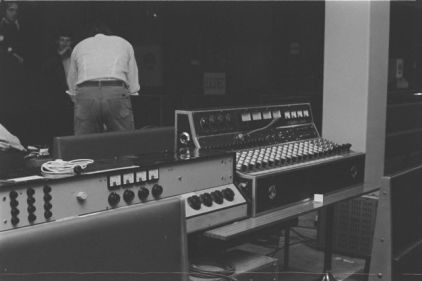
14 Feb., 1970 – Leeds University Refectory, recording equipment.
Late 1969/early 1970, for front-of-house amplification, the WEM PA designed by Bobby Pridden employed 12 4×12″ column speakers on each side of the stage, totaling approximately 1,500 watts power output for the PA.
Remainder of 1970, the speaker system contains no horns, just banks of cone devices in 10″, 12″ and 15″ speakers (approximated: six 8×10 Marshall cabinets; 4×12 WEM PA columns; WEM 2×15 and 4×12 cabinets).
Foldback comprises a collection of WEM columns and cabinets variously placed around the backline, including behind the drumkit, angled forward at the far left and right sides of the stage, and directly at the front of the stage from the left and right. In addition, the first instance of the guitar and bass signal being “monitored” at the opposite sides of the stage, by a single Hiwatt amp and cab at each side of the stage — a Hiwatt amp and cab at stage left next to Pete’s four Hiwatt cabinets, and a Hiwatt amp and cab at stage right next to John’s rig.
The Who also began developing their own stage lighting in 1970.
Of note, the 3rd Annual 1970 Isle of Wight festival in August 1970 relied on the Who’s PA and featured a WEM 5,000-watt PA, the loudest ever assembled, comprised loads of WEM 4×12 PA columns and various WEM 8×10 and 2×15 enclosures, among others, per side, plus more on the towers. Each stage side was topped by WEM’s parabolic focusable reflector. (See ukrockfestivals.com for a collection of Isle of Wight photos depicting the PA.)
Anyway Anyhow Anywhere:
The Who arrived in America in June (1970) for a month-long tour, commencing with two concerts at New York’s Metropolitan Opera House. Setting standards for sound and presentation, this was the Who’s first meticulous juggernaut around America, requiring three tons of specially built Charlie Watkins gear to be flown in, including a 4000 watt stereo system, designed by Townshend and Bob Pridden, that incorporated mixers placed at the front and back of each venue. A special custom-built truck, with a five-man crew, transported it across the continent.
For better or worse, the Who were pioneering that dubious animal, stadium rock.
New: The Who at Leeds University Refectory, 14 February 1970, gig profile.
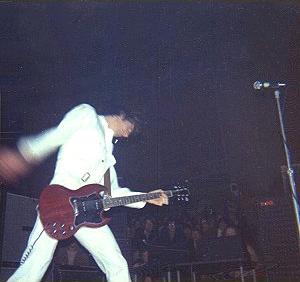
30 Jan., 1970, Amsterdam, Concertgebouw, view of Bobby Pridden’s mixing desk next to WEM foldback columns. Courtesy The Who Netherlands Photo Gallery (offline). ©Henk Hulstkamp.
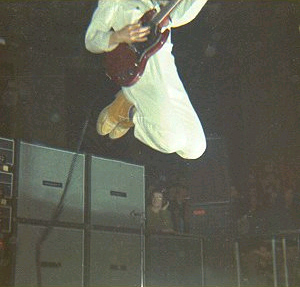
30 Jan., 1970, Amsterdam, Concertgebouw, view of WEM foldback columns stacked next to Bobby Pridden’s mixing desk. Third single 4×12 Hiwatt SE4122 is monitor of bass. Courtesy The Who Netherlands Photo Gallery (offline). ©Henk Hulstkamp.
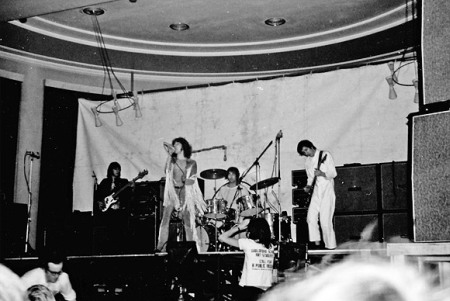
14 Feb. 1970 – Leeds University Refectory, Marshall 8×10s visible at far right.
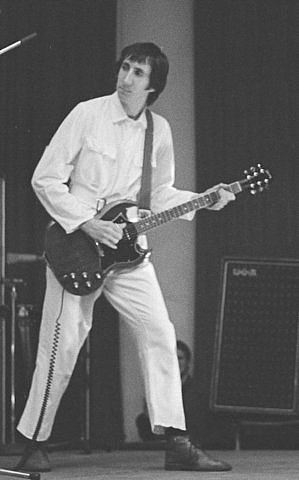
14 Feb. 1970 – Leeds University Refectory, WEM foldback column on stand visible at right.
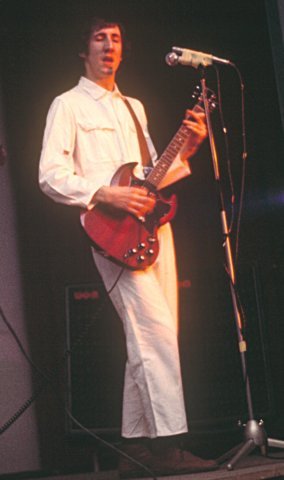
14 Feb. 1970 – Leeds University Refectory, WEM foldback columns on stands visible at right.
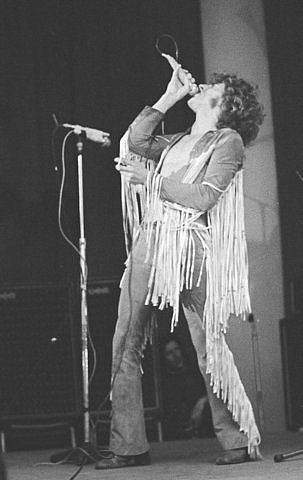
14 Feb. 1970, at Leeds University Refectory, WEM foldback columns on stands visible at stage right.
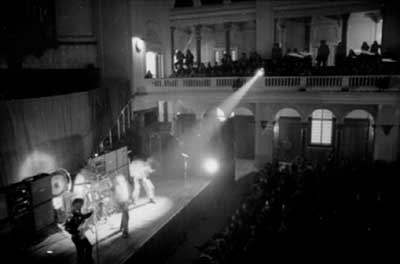
15 Feb. 1970 – Hull City Hall.
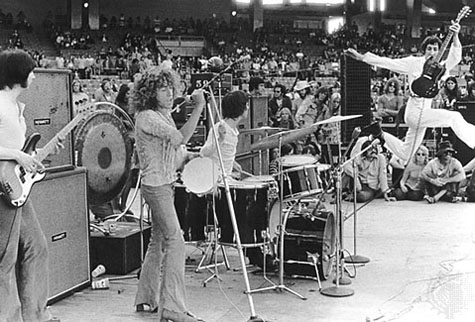
14 June, 1970, at Anaheim Stadium, Anaheim, Calif., showing WEM columns at backline and far left of stage.
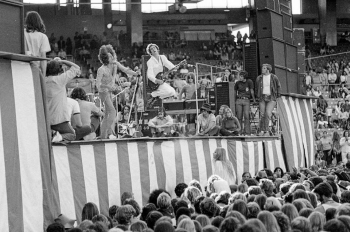
Click to view larger version. 14 June, 1970, at Anaheim Stadium, Anaheim, Calif., showing WEM columns at backline and side of stage; FOH PA stacks of Marshall and WEM cabinets; two WEM Audiomaster mixing consoles manned by Bobby Pridden at stage right, with three WEM 100-watt amplifiers stacked behind the WEM speaker column.
29 Aug., 1970, 3rd Annual Isle of Wight festival
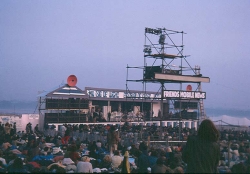
Click to view larger version. 29 Aug., 1970, 3rd Annual Isle of Wight festival, The Who’s PA and featured a WEM 5,000-watt PA, the loudest ever assembled.
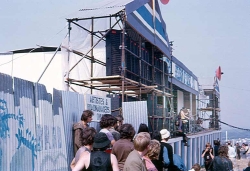
Click to view larger version. 29 Aug., 1970, 3rd Annual Isle of Wight festival, The Who’s PA and featured a WEM 5,000-watt PA, the loudest ever assembled. WEM’s parabolic focusable reflector visible at top right.
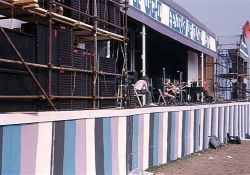
Click to view larger version. 29 Aug., 1970, 3rd Annual Isle of Wight festival, The Who’s PA and featured a WEM 5,000-watt PA, the loudest ever assembled.
Notable events:
- 1970:
-
WEM introduces the Watkins Festival Stack, consisting of 2×15″ woofers, 2×12″ in high bass, 6×10″ in mid and high-mid range, and Vitavox or Celestion horns.
-
Phase Linear introduces the 200-watt power amplifier.
Auction profiles
All auction information, including quotes and references are copyright their original owners and are included for reference only. Whotabs makes no claim that these auctions represent authentic Who-used items.
The Who and Rick Nielsen WEM Audiomaster Mixer
Julien’s Auctions “Music Icons 2016” on 21 May 2016
A WEM Audiomaster mixer formerly owned by John Entwistle and used by The Who and Led Zeppelin early in their careers. Rick Nielsen of Cheap Trick, the mixer’s current owner, obtained the mixer when working with Entwistle and Roger Daltrey in 1992. The same or similar mixer can be seen here in a photograph taken at the Isle of Wight Festival in 1970. The five-channel mixer is serial number CW 49330. Accompanied by a letter of authenticity and guitar picks from Nielsen, and case.
Mixer, 11 by 16 1/2 by 21 1/4 inches; Case, 24 by 13 by 20 inches
Estimate: $2,000 – $4,000
Realised: U.S.$8,750
Resources and Information
Acknowledgements
- Bob Heil
- Dave Goessling
Special thanks to John Hughes (john@pureneasy.fsnet.co.uk) for assistance with this page.
Sources and related sites:
- Cream amplification: twtd.bluemountains.net.au/cream/amplification.htm (archived)
- Pink Floyd amplification: geocities.com/deadhead20.geo/PFlive.html (archived)
- The Grateful Dead’s “Wall of Sound”: dead.net/cavenweb/deadfile/newsletter19soundrap.html (archived)
- Max The Mod: westminsterinc.com/who1965/equip.htm (offline).
- Rock Hardware: The Instruments, Equipment and Technology of Rock. Edited by Tony Bacon. Harmony Books. 1981.
- The Who Concert File, by Joe McMichael and ‘Irish’ Jack Lyons. Omnibus Press.
- Guitar Player: The Who’s Sound System. How it grew from 200 to 75,000 watts. By Steve Caraway and Tom Wheeler. November 1977.
- repfoto.com.
- Sunn: Unofficial Sunn Museum and The Sunn Shack (archived)
- Watkins Guitar World: watkinsguitars.co.uk
- ML Executives: mlexecutives.org (archived)
Articles
- “Rock hall hails Heil’s wizardry. Metro-east native created equipment for stars.” From the Belleville (Illinois) News-Democrat (archived version), Tuesday, 9 May, 2006
- “Bob Heil: A Living Live-Sound Legend,” from Musician’s Friend (archived), May 2006
- Guitar Player: The Who’s Sound System. How it grew from 200 to 75,000 watts. By Steve Caraway and Tom Wheeler. November 1977.
Manufacturer’s sites
- Watkins Electric Music (WEM): wemwatkins.co.uk
- Bob Heil: heilsound.com
- Marshall Amplification: marshallamps.com
- Vox: voxshowroom.com
- Crown Audio: crownaudio.com
- Showco: showco.com
- Phase Linear History: phaselinearhistory.com
- Shure: shure.com
- Sunn: sunnamps.com
- Revox: revox.ch and reeltoreel.de
- Martin Audio: martin-audio.com
- Midas: midasconsoles.com
